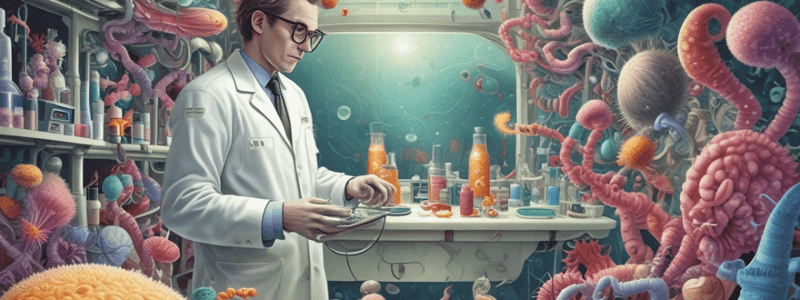Podcast
Questions and Answers
What is a common method of sterilization besides autoclaving?
What is a common method of sterilization besides autoclaving?
What is a mechanism of action of microbial control agents that involves rupturing the cell membrane?
What is a mechanism of action of microbial control agents that involves rupturing the cell membrane?
What is a type of chemical method of sterilization?
What is a type of chemical method of sterilization?
What is a mechanism of action of microbial control agents that involves damaging cell wall components?
What is a mechanism of action of microbial control agents that involves damaging cell wall components?
Signup and view all the answers
What is an example of a dry heat sterilization method?
What is an example of a dry heat sterilization method?
Signup and view all the answers
Which microbial control agent damages proteins and nucleic acids?
Which microbial control agent damages proteins and nucleic acids?
Signup and view all the answers
What is the primary mechanism of action of autoclaving?
What is the primary mechanism of action of autoclaving?
Signup and view all the answers
Which method of sterilization is most effective against heat-resistant microorganisms?
Which method of sterilization is most effective against heat-resistant microorganisms?
Signup and view all the answers
What is the primary difference between autoclaving and dry heat sterilization?
What is the primary difference between autoclaving and dry heat sterilization?
Signup and view all the answers
Which of the following mechanisms of action is NOT a common method of microbial control?
Which of the following mechanisms of action is NOT a common method of microbial control?
Signup and view all the answers
Study Notes
Sterilization Procedures
- Autoclaving: a method that uses high-pressure steam to kill microorganisms
- Dry heat sterilization: a method that uses hot air to kill microorganisms
- Filtration: a method that uses a physical barrier to remove microorganisms from a solution
- Chemical methods:
- Glutaraldehyde: a chemical disinfectant that kills microorganisms
- Ethylene oxide: a chemical sterilant that is used to sterilize heat-sensitive materials
Mechanisms of Action of Microbial Control Agents
- Damage to the cell wall: microorganisms are killed by disrupting the structure and function of their cell walls
- Alteration of cell membrane permeability: microorganisms are killed by changing the permeability of their cell membranes, preventing them from functioning properly
- Damage to proteins and nucleic acids: microorganisms are killed by damaging their proteins and nucleic acids, preventing them from carrying out essential cellular functions
Studying That Suits You
Use AI to generate personalized quizzes and flashcards to suit your learning preferences.
Description
Test your knowledge of sterilization procedures, including autoclaving, dry heat, and chemical methods, as well as the mechanisms of action of microbial control agents. Learn about the effects on cell walls, membranes, proteins, and nucleic acids.



